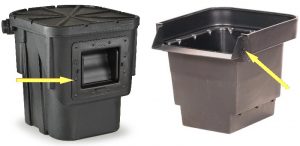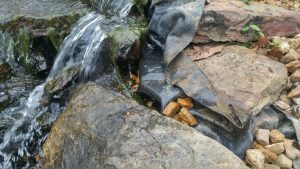How to Fix a Leaking Pond or Pond Leak
Pond Leaks Debunked
A “leak” with regards to a pond is a 4 letter word, without question. In most cases, there are only a few sources to cause a pond leak:
- Pond Skimmer or Waterfall Filter
- Canister (Pressure) Filter O-ring or hose connection
- A low spot in pond liner/ waterfall liner
- Hole in pond/waterfall liner (holes do not magically appear in EPDM pond liner; if there is a reason to believe there is a hole in the liner, we typically know the reason and they know roughly where to look for the hole). Patching a hole is easy.
- Faulty Hose: upgrading to a heavy-duty Freeze Flex PVC or heavy-duty kink free hose eliminates problems.
Pond Skimmers and Waterfall Boxes typically start to leak at the 8-10 year mark because the screws or bolts disintegrate. These two pieces of equipment fasten to the liner in one fashion or another and the screws keep the seal tight. Once disintegrated, the seal is compromised. Removing the hardware, applying new pond silicone, and installing new hardware usually solves this problem.
Another source of the leak could be the bulkhead fitting in the back of the waterfall box or waterfall filter. Over time, pressure from the earth pushes against the boxes causing the bulkhead fitting (where the hose attaches) to separate from the tank compromising the seal. Replacing this fitting can solve the problem.
How to Seal a Pond Skimmer and Waterfall Filter
Although these videos show installing a skimmer and waterfall box from scratch, the resealing process is pretty much the same.
Fixing a Low Spot in the Liner
As you can see in the photo below, water can easily find it’s way out of the waterfall. We were able to find this leak in a few minutes after moving a stone. To fix the problem in the photo below, the excess liner on the right needs to be folded up to the left to prevent water from exiting the waterfall.
Finding a low spot in the liner can be tough because pond liner used in ponds and waterfalls is covered with stone, plants, rocks, gravel, etc. Let’s define low spot so we are all on the same page: a “low spot” occurs in ponds where the ground settles in an area, typically not a large area, and pond liner is too low allowing a small amount of water to go out of the pond. This can happen in pond liners as well as “waterfall liners” or an area of the waterfall/ stream area. To find this area, the perimeter of the liner has to be visible.
Most liners are cut after installation. 3-5 years down the road, after the ground fully settles, low spots result. Sometimes there is enough excess liner to pull up and anchor with stone. Sometimes there is not enough liner to pull up. In this case, it may be possible to use seam tape, also called cover strip or patch material, and seam in a piece of liner. These types of seams will be watertight as long as tape activator, or primer, is used with the seam tape and piece of liner. If not, a new liner may need to be installed (hopefully not).
Easily Finding the Leak: Process of Elimination
- Fill the pond up (be sure to use dechlorinator)
- Mark the water line
- Turn the pump off for 12 – 24 hours (in hot weather, or in ponds with heavy fish loads, be sure to add an aeration kit to prevent fish loss from lack of oxygen)
If the pond DOES leak with the pump off, there are only a few choices:
- Leaking pond skimmer (if applicable)
- Low spot in the pond liner
- Hole in the pond liner
If the pond DOES NOT leak with the pump off, then there are only a few choices:
- Waterfall box seal is leaking where liner fastens to waterfall box
- The waterfall box is leaking where the hose connects to the waterfall box
- Somewhere between the waterfall box and the pond, the liner has settled allowing water to flow out of the waterfall/ stream area


